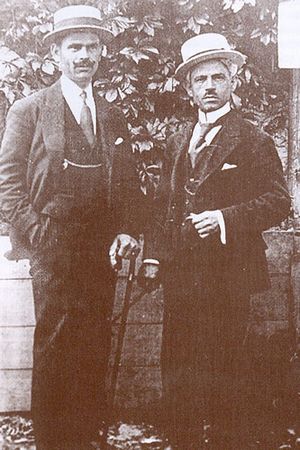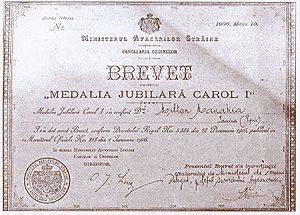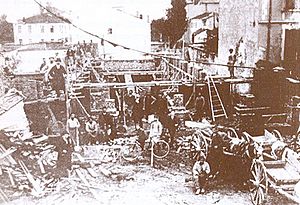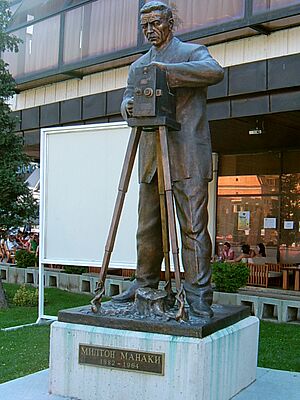Manaki brothers facts for kids
Quick facts for kids
Yanaki and Milton Manaki
|
|
|---|---|
| Ienache (Yanaki) and Miltiade (Milton), Manachia (Manaki) (Aromanian) | |
 |
|
| Born | 1878 (Yanaki) 1882 (Milton) Avdella, Ottoman Empire, Manastir Vilayet (present-day Greece )
|
| Died | 1954 Thessaloniki, Greece (Yanaki) 1964 Bitola, SR Macedonia, Yugoslavia (Milton) |
| Occupation | Filmmakers, photographers |
| Years active | 1905—1964 |
The Manaki brothers, Yanaki and Milton, were amazing Aromanian photography and cinema pioneers. They lived in the Balkan Peninsula and the Ottoman Empire. They were the first to bring a film camera to the city of Manastir (now in North Macedonia). This city was a big center for trade and culture.
Their very first film, The Weavers, was super short, only 60 seconds long! It showed their grandmother spinning and weaving. This film is known as the first movie ever shot in the Balkans. The brothers used a special 35 mm Urban Bioscope camera. Yanaki bought this camera from London in 1905. They filmed many short movies about everyday life in Manastir.
The Manaki brothers became famous for their photography studio. In 1906, King Carol I of Romania invited them to an exhibition in Bucharest. They won a gold medal for their photos and became the King's official photographers! Later, they also became official photographers for the Ottoman Sultan and the King of Yugoslavia Alexander Karađorđević. In 1921, they built an outdoor cinema called Manaki. They later turned it into an indoor movie theater, but sadly, it burned down in 1939.
Today, the National Archive of North Macedonia keeps more than 17,000 photos and over 2,000 meters of film from the Manaki brothers. Their work shows important historical events like the Ilinden Uprising, the Balkan Wars, and World War I. They left behind a rich collection that helps us understand the history and culture of Southeast Europe. To honor them, the Manaki Brothers Film Festival is held every year in North Macedonia.
Contents
The Manaki Brothers' Lives
Early Years and Education
Yanaki and Milton were born in a village called Avdella. This village was near the town of Grevena in the Ottoman Empire. Milton was born in 1882, and Yanaki was born in 1878. Their family were Aromanian and owned a lot of land. Their parents also bought and sold livestock and lent money.
The area where they lived became important for the Romanian national movement among the Aromanians. Their father, Dimitrios, was part of this movement. Both brothers went to Romanian elementary school in Avdella. Milton went to high school in Yanya, and Yanaki went to high school in Manastir. Yanaki loved painting, writing, and photography when he was in high school. Milton didn't like high school and left after one year. His parents tried to teach him a craft, but he came back home. After high school, Yanaki worked as a teacher.
Starting a Career in Photography
Yanaki started his first photography studio in 1898. He was working as an art teacher in a Romanian school in Yanya at the time. Yanaki asked his brother Milton to join him and learn photography. Milton quickly became very good at it.
Yanaki bought some land on the main street of Manastir, which was an important city. In 1904, both brothers began building their own workshop. They called it the "Atelier for Photographic Art." Yanaki moved to Manastir for good in 1905. Milton first helped clean the studio and take care of the equipment. Later, he learned photography and became an expert. Milton also took about fifty photos of Aromanian revolutionaries.
The Manaki brothers loved to travel. They went to many European cities. In 1905, they went to Bucharest and heard that film cameras could be bought in London. Yanaki was very interested. On his way back, he stopped in England and bought a Bioscope 300 film camera. With this camera, they filmed their 114-year-old grandmother, Despina. This was the first film ever shot in southeastern Europe! It was made only ten years after the first films by the famous Lumière brothers.
Official Photographers and Filmmakers
King Carol I invited them to Romania again for a photography contest in 1906. They won gold and silver medals and were named the official photographers of the Romanian King. The brothers traveled around, taking photos, especially in Aromanian villages.
Besides photography, they started making documentaries. During the Young Turk Revolution in 1908 and 1909, they took about 450 photos and a short film. These recorded all the important events of that time. In 1909, they filmed the arrival of the Romanian royal group in Manastir. They also filmed the visit of the Turkish Sultan Mehmed V to Manastir in 1911. Milton filmed the Sultan arriving by boat, his train journey, and his welcome at the train station. That same year, they became official photographers for the Ottoman Sultan.
The First Balkan War began in 1912. Manastir was taken over by the Serbian army. Milton and Yanaki took over 200 photos of Serbian officers, soldiers, and important political leaders.
In 1914, Milton visited his family. When he returned, he was briefly recruited by the Serbian army but was soon released. Because of the wars from 1914 to 1915, the brothers didn't do much work and faced money problems. When the Serbian army left Bitola, Bulgarian officers found three shotguns in their studio. Yanaki was sent away to Bulgaria, even though Milton had bought the guns. Yanaki bought land in a Bulgarian village and started raising horses. During World War I, Bitola was bombed, and Milton often traveled to Thessaloniki.
Their photography work picked up again in 1916. Bulgarian and German officers wanted their pictures taken at the studio. Milton took many portraits of officers and soldiers from different countries. But in late 1916, Serbian and French soldiers took over Bitola again. The city was bombed by German and Bulgarian forces. Bombs hit their studio and destroyed their camera and other equipment. Yanaki returned from Bulgaria in 1919. He and Milton decided to close the damaged studio.
Expanding into Cinema
The brothers started focusing more on cinema in 1921 to earn money. They bought a film projector and opened an outdoor cinema on the main street. In 1923, they turned it into an indoor theater, the first movie theater in Bitola. They named it "Manaki."
They made more movies, including greetings from Alexander I of Yugoslavia to Bitola. They also filmed a memorial for lost French and Serbian soldiers. Other films included a 1922 explosion in Bitola and two weddings.
In 1928, the Manaki brothers wrote to the Serbian Royal Court. They asked to be named official royal photographers, just like they were for the Romanian king and Ottoman sultan. Their request was approved in 1929.
In 1935, Milton married Vasiliki Dauka, and their son Leonid was born. Yanaki left Bitola in 1937, leaving Milton to work alone. Milton filmed one of his most famous documentaries, The Bombing of Bitola, in 1940. During World War II, the area was taken over by Bulgaria. Milton got a license to work as a photographer and took over 1200 photos. When the Germans left in 1944, the Yugoslav Partisans took over Bitola. Milton filmed this event. During this time, Milton took about 5,000 photos of many things: politics, weddings, sports, and more. Some of his most important photos are of Josip Broz Tito in Bitola.
Later Years and Recognition
Yanaki stopped working in photography in 1935 and moved to Thessaloniki, Greece. He lived there for the rest of his life. Milton sold all of his 1500 meters of film to the government of Socialist Republic of Macedonia for a lot of money. Milton also worked with the Cinematique of Yugoslavia in Belgrade. The government made copies of all the films and returned the originals to Milton in 1954. Milton continued to work as a photographer and filmmaker for the government until he passed away.
In 1957, the Organization of Yugoslav Film Makers made Milton an honored member. They recognized him as the first filmmaker in the region. Zagreb Film made a documentary about Milton's work in 1958. Milton also received a special diploma from the National Technique of Macedonia. Milton stayed in Bitola, Yugoslavia, until he died in 1964.
Manaki Brothers' Films
| Film | Year | Running time | Theme | Milton | Yanaki |
|---|---|---|---|---|---|
| Grandmother Despina | 1905 | 60 seconds | weaving | Yes | Yes |
| Weavers | 1905 | 60 seconds | weaving | Yes | Yes |
| Outdoor School | 1905 | 120 seconds | school | Yes | Yes |
| Parade of Military Band, Carriages and Horsemen | 1908 | 60 seconds | Young Turk Revolution | Yes | Yes |
| Events marking Hurriyet | 1908 | 120 seconds | Young Turk Revolution | Yes | Yes |
| Turks Hold Speech | 1908 | 120 seconds | Young Turk Revolution | Yes | Yes |
| Parade to Mark Hurriyet | 1908 | 4 minutes | Young Turk Revolution | Yes | Yes |
| Manifestations (With Greek Inscriptions) | 1908 | 60 seconds | Young Turk Revolution | Yes | Yes |
| Events Marking the Young Turk Revolution | 1908 | 120 seconds | Young Turk Revolution | Yes | Yes |
| The Funeral of the Metropolitan Aimilianos of Gravena | 1911 | 6 minutes | funeral | Yes | Yes |
| Panorama of Grevena | 1911 | 60 seconds | Grevena | Yes | Yes |
| Romanian Delegation Visiting Bitola, Gopesh, Resen | 1911 | 120 seconds | Yes | Yes | |
| Turkish Sultan Mehmed V Reshad Visiting Bitola | 1911 | 16 minutes | Ottoman Sultan Mehmed V | Yes | Unknown |
| Church in Grevena | 1911 | 60 seconds | Grevena | Yes | Yes |
| Alexander Karađorđević Visiting Bitola | 1912 | 4 minutes | Alexander I of Yugoslavia | Yes | Yes |
| Opening the City Restaurant in Bitola | 1912 | 120 seconds | Bitola | Yes | Yes |
| Welcoming of the Greek King and Heir to the Throne Paul by General Bojovic, in Bitola | 1912 | 60 seconds | Paul of Greece | Yes | Yes |
| Bombing of Bitola | 1940 | unknown | World War II | Yes | No |
| Entering of the National Liberation Army in Bitola | 1944 | unknown | World War II, Socialist Yugoslavia | Yes | No |
| Greeting of Tito in Bitola | 1963 | 20 minutes | Josip Broz Tito | Yes | No |
| Source: Cinematheque of Macedonia | |||||
The Manaki Brothers' Legacy
The Manaki brothers are seen as the first filmmakers in many countries, especially in the Balkans. Their films were the start of "ethnographic documentaries" in the region. These are films that show the culture and way of life of different groups of people. They are famous for capturing important historical events before, during, and between World War I and World War II. Most of their work is kept in film archives in North Macedonia and Greece. Sadly, some of their photos and films were lost or destroyed. This happened during the 1916 bombing of their studio and the 1939 fire at their theater.
A movie called Ulysses' Gaze by Theo Angelopoulos is about a search for a lost film reel made by the Manaki brothers. The movie starts with images of their grandmother spinning wool, just like their first film. The first documentary about the Manaki brothers was made by Zagreb Film in 1958. A Greek documentary about them was released in 1988.
To honor the brothers, the Manaki Brothers Film Festival is held every year in Bitola. Milton lived in Bitola for 60 years until he passed away. The festival started on May 21, 1950. At the festival, the winner gets the "Golden Camera 300" award. This award is named after their famous camera. This festival is the main and oldest film festival in North Macedonia. In 2011, the local government said they would rebuild the Manaki Brothers Film Theater that burned down in 1939. In 2012, the Cinematheque of Macedonia announced that the Manaki brothers' films would be restored and made into digital copies.
Historical Images















